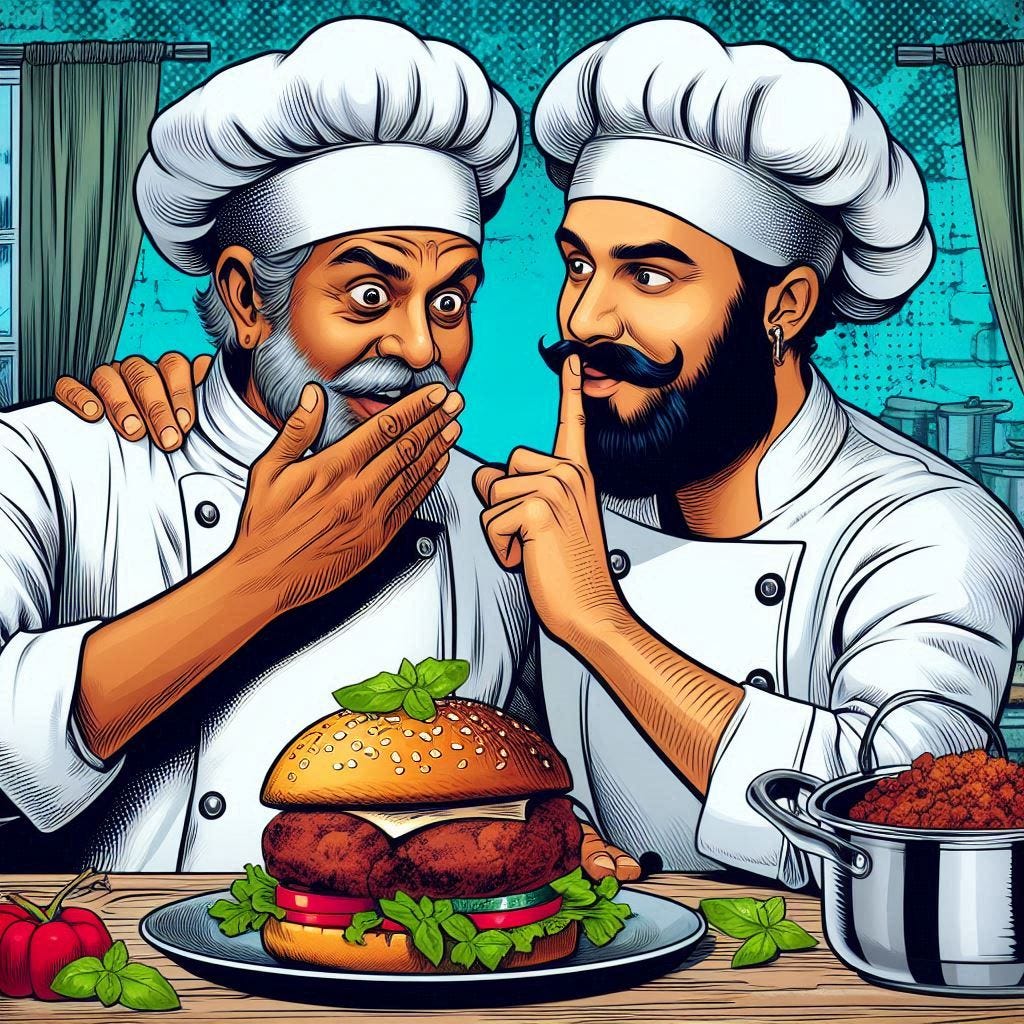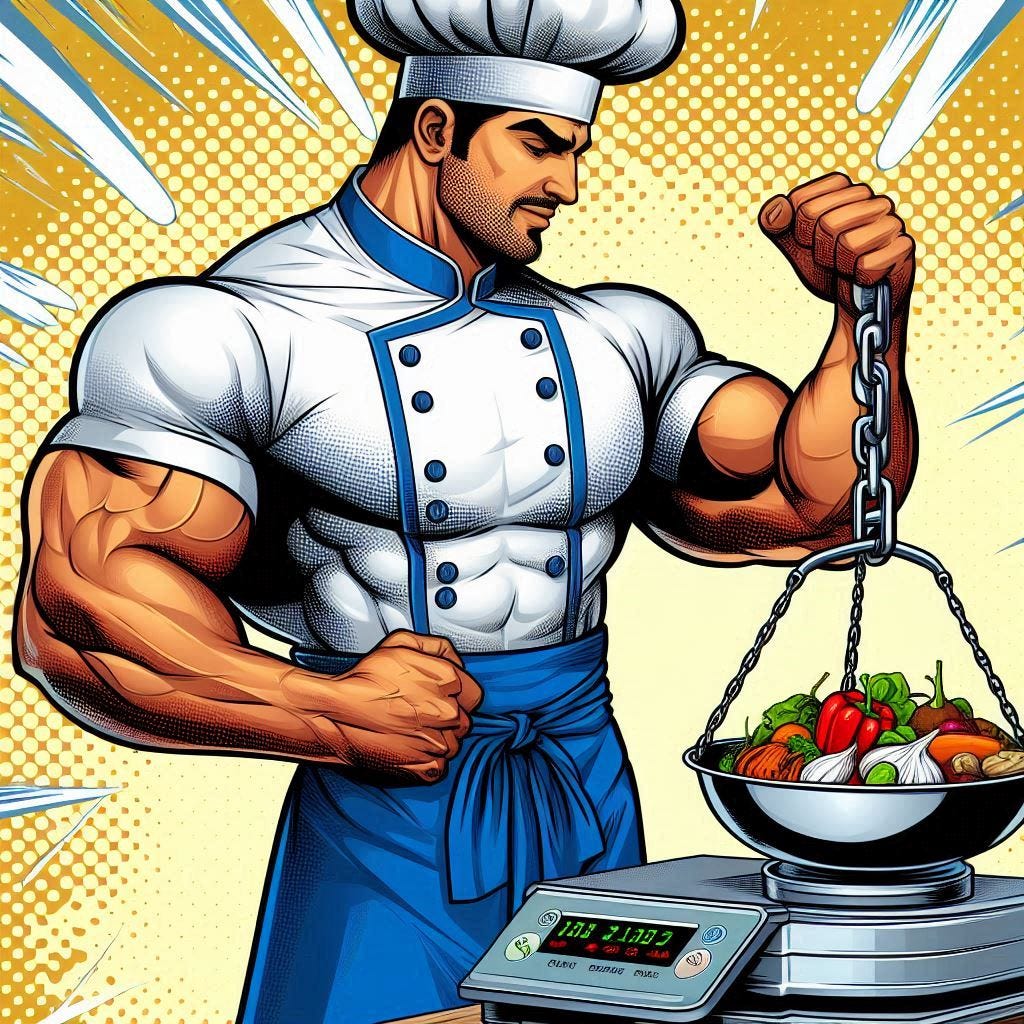you're probably undersalting your food
if no one has ever complained that your food is too salty, you're just not being aggressive enough
In this post I’ll say four things:
The most common cooking mistake I see is not adding enough salt.
You must develop your palate to tell what undersalted and oversalted taste like. Otherwise your food will forever taste bland, like there’s something missing, and you will call it Fate.
Fortunately, developing your salt palate doesn’t have to be subjective and confusing. Do this exercise: make unsalted hummus at home and then salt it to match a reference hummus you buy from the store.
You can also salt your food by weight, but beware! Do not neglect to develop your palate! You won’t always be in a position to measure out 1% salt by weight.
I hate to waste your time so I put everything that needed to be said in the list above. Continue reading for more exercises, and for images of sexy jacked Indian guys. Your time is best spent actually doing the exercise, but I get it. You’re on your phone, you’re at your computer, and you would like to be entertained. You got it.

undersalting is very common
People often bring me something they made and ask “I think I’m nearly there but something’s missing, that je ne sais quoi, can you help me figure it out?”, expecting me to pull a cool magic spice out of my pocket. No, it’s salt. The something you’re missing is salt. Even people who’ve been cooking for many years make this mistake far too often. Restaurants are much better and will usually serve correctly-seasoned food, but not always.
And I’m not talking about differences in individual taste. De gustibus non est disputandum, but food can legitimately be so undersalted that nearly everyone agrees it’s been improved after adding more salt.
It’s sad both because the fix is so easy — just add more salt! — and the damage so profound. Imagine going through your whole life with severe myopia, accepting that the world is blurry, not even knowing that your world is blurry. The trees, the dappled sunshine, the architectural details, the Milky Way, all smeared into blobs. And then putting on glasses for the very first time. Gasp — my god, it’s full of stars! Maybe your food is actually delicious, if only you could bring it into focus with a little more salt.
how to salt
I feel silly writing this section because you have surely heard this before and I hate being tedious, so I’ll be brief.
Add some salt, mix, then taste. Is it still undersalted? Then add more salt and repeat. It’s fine to have more than 5 iterations of salting.
Once it’s properly salted, repeat the process with acid and sweet, if using.
Once it’s properly acid-and-sugar-ed, decide if it needs more salt. Sometimes adding acid and/or sugar creates the potential for making it yummier by adding more salt. Do not neglect this potential! Be an emotionless yummy-maximizing robot.

Salt at various steps of the cooking process so you can taste intermediate stages more accurately. Remember the analogy that salt brings taste into focus. Tasting undersalted food is like evaluating a blurry picture.
you must train your palate to detect undersalting
Oversalted food is very obvious to nearly everyone: it tastes bitter, electric, very salty. Seawater is unpleasantly salty. Pecorino romano and feta are both quite salty, at the upper end of palatable. Miso is very salty, unpalatably so, and must be diluted. Soy sauce is even saltier, and often used as a substitute for salt.
By contrast, when food is undersalted it is not so immediately obvious to the untrained palate. It just tastes meh. Bland. Like what my vegan friends in college made, and I blamed on the lack of meat.
Exercise 1: salt a small sample
Every time you cook something and you think it’s anything less than phenomenal, take a small amount in a bowl and add more and more salt, tasting as you go, until it it’s unpalatably salty. Somewhere between “less than phenomenal” and “blech — way too salty”, it will taste its best.
This trains your palate to taste potential: “this would be yummy, if only it had more salt”.
This exercise also sidesteps normal people’s fear of salt: because the amount of food is small, so is the amount of salt necessary.
The biggest obstacle is psychological: people recoil at the amount of salt it takes to make food taste good. But this horror is inconsistent with the delight with which they eat processed snacks and restaurant food, which joyfully use heaps of salt in their pursuit of hyperpalatibility.
Exercise 2: make soup good again
Soup is a fantastic medium for learning to salt. Make soup, any soup, from scratch, and then salt it until it tastes yummy. This will take multiple teaspoons, perhaps tablespoons of salt. Then salt it a little more, until it’s too salty. Then add some water to fix the problem.
This trains you to become comfortable with the amounts of salt you actually need for a potful of food.
This exercise also shows you that oversalting is not always a disaster. Any kind of dilution will fix it. Water is the handiest diluter.
use a reference food
The previous exercises require a subjective judgement of whether the food tastes yummy. Can we do better? Yes: we can season something to match a standard reference food. Food scientists and the industrial giants that employ them are so very good at their jobs. They know how to make processed food taste great, and they also produce that tasty food consistently and at low prices. The magic of capitalism means that you can just go buy hummus or a can of soup and trust that it’s been salted to perfection.
Exercise 3: copycat hummus
Buy Sabra or some other hummus from the store. Make hummus at home using canned chickpeas, tahini, some neutral oil (vegetable or avocado), and a clove or two of garlic.
Now slowly add salt and vinegar to the homemade hummus until it tastes as seasoned as the commercial hummus.
I assigned this as homework in one of my classes. I needed to give each student both the base and reference hummuses but I was having trouble finding that many little containers. I finally found a deli nearby that would sell me disposable coffee cups with lids. So the students got coffee cups of hummus.
You can use powdered citric acid instead of vinegar for a more neutral acid. It’s what Sabra brand uses so you’re likelier to be able to get it spot-on.
You can do this exercise with other foods. I like using hummus for it because making the base is easy: just put three or four pantry ingredients in a blender. I would love to hear your suggestions for other foods to do this with, especially if there’s something simpler than hummus!
salting by weight
Sometimes you can’t just use your palate to get the salt right, like if you’re lacto-fermenting something or cooking sous vide or making very large quantities. Adding salt by weight can be useful. So you weigh your food and then add somewhere between 0.5% and 2% of that weight in salt. Lacto-fermentation typically uses 2% salt by weight, while some chefs swear by half a percent as ideal for most food.
You can certainly do this and it’s great for being precise and repeatable, but don’t let it be a crutch. When you have a pot of soup or stew simmering, and you’ve been adding veggies and water to it, and water has also been evaporating, you have no idea what its weight is. It would be so inconvenient to have to weigh it, never mind the potential for burns and mess as you slosh around a large amount of very hot liquid.
Or when you crack 5 eggs into a cast iron stove and stir them around to scramble. Or if you toss up a salad of some greens, carrots and scallions. Do you really want to be bringing out that kitchen scale every time? Just train your palate.
A well-trained salt palate is invaluable for debugging your own and other people’s food. If it isn’t one of your strengths yet, rejoice, for this skill is straightforward to develop.
uhh isn’t eating this much salt bad for me
Uhh I don’t know, maybe salt is kinda bad especially if you have a family history of kidney stuff? I really don’t know. The literature is vast and confusing and I am but a simple man who wants food to taste good. Nothing on this blog is ever medical advice.
But have you considered that if you eat out all the time then you’re already getting this level of salt or more, because that’s how come it tastes so good? At least at home you can gradually reduce the salt level if that’s something you’re interested in. Home cooking gives you control, and all I really want is for you to cook more.
Anyway the way our bodies regulate blood volume and sodium concentration is beautiful, like there are stretch sensors in our hearts and arteries that detect changes in blood volume. And there are sensors in the hypothalamus region of the brain that detect the concentration of stuff dissolved in the blood (mostly sodium). These sensors influence the secretion of a hormone called vasopressin that influences whether the kidney retains or excretes water, sodium and other stuff. Read about it more here.






This hummus exercise is genius! I gotta give it a go
great post! can you expand on the robot thing please?